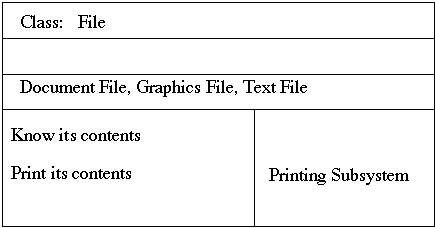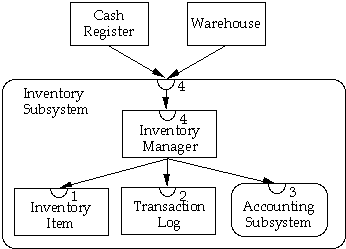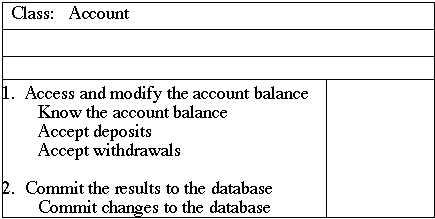 CS535 Object-Oriented Programming & Design
CS535 Object-Oriented Programming & Design
Fall Semester, 1996
Doc 29, OO Design Analysis Phase
[To Lecture Notes Index]
San Diego State University -- This page last updated Nov 26, 1996

Contents of Doc 29, OO Design Analysis Phase
- References
- Analysis Phase
- Hierarchies
- Building Good Hierarchies
- Identifying Contracts
- Subsystems3
- Collaboration graphs
- Identifying Subsystems
- Protocols
- Refining Responsibilities
- Specifying the Design
- Review of Design Process
Designing Object-Oriented Software, Wirfs-Brock, chapters 6 - 8
- Determine which classes are related via inheritance
-
- Finding abstract classes
-
- Determine class contracts
- Finding Object Interaction
- Divide responsibilities into subsystems
-
- Designing interfaces of subsystems and classes
- Construct protocols for each class
-
- Produce a design specification for each class and subsystem
-
- Write a design specification for each contract
Hierarchy Graphs

Venn Diagrams

Model a "kind-of" hierarchy

Multiple inheritance can be used in the design even if you use an
implementation language with single inheritance.
Make sure that abstract classes do not inherit from concrete classes
Eliminate classes that do not add functionality
Factor common responsibilities as high as possible



Contract[1]
- Set of requests that a client can make of a server
-
- Cohesive set of responsibilities that a client can depend on
-
- Abstraction of a set of responsibilities of a class
-
-
Example: Account Class
- Contract: Access and modify the account balance
-
- Responsibilities:
- Know the account balance
-
- Accept deposits
-
- Accept withdrawals
Identifying Contracts
Group responsibilities used by the same clients
Maximize the cohesiveness of classes
- Contract of a class should make sense together
-
Minimize the number of contracts
-
- Use inheritance
-
- Set of classes all supporting a common contract should inherit the contract
from a common superclass
-
-
Applying the Guidelines
- Start defining contract at the top of the hierarchies
-
- Name and number each contract
-
- For each collaboration, determine which contract represents that
collaboration
Contracts[2]
Another View
Precondition
- The constraints under which a routine will function properly
-
- "Push" may not be called if a stack is full
-
- "Pop" may not be applied to an empty stack
Postcondition
- Properties of the state resulting from a routine's execution
-
- After a "push," the stack may not be empty, its top is the element just
pushed, and its number of elements has been increased by one
Contract
- A client must insure that the precondition holds before calling an operation
-
- The server will guarantee that the postcondition holds
The contract forces a clear definition of whose responsibility it is to check
every condition required for correct operation
Invariants and Correctness
Class invariant is a list of all properties of the instances of a class, which
must be preserved by all operations
Example: Stack class invariants
- 0 <= number of elements in the stack <= max stack
size
See [Gries, 1981] and [Meyer, 1990] for more details.
Subsystems are groups of classes, or groups of classes and other subsystems,
that collaborate among themselves to support a set of contracts
There is no conceptual difference between the responsibilities of a class and a
subsystem of classes
The difference between a class and subsystem of classes is a matter of scale
A subsystem should be a good abstraction
There should be as little communication between different subsystems as
possible

Top-Down, Bottom-Up
Large Systems
Most texts illustrate OO design "bottom-up"
- Find objects
-
- Determining responsibilities
-
- Determine object collaboration
-
- Find hierarchies
-
- Determine subsystems
Large systems are designed "top-down"
- Find top level subsystems
-
- Determine subsystem responsibilities
-
- Determine subsystem collaboration
-
- Find hierarchies
-
- Iterate above steps on each subsystem
Each level is built "bottom-up"
Levels are done "top-down"
Top-Down, Bottom-Up
Large Systems
Jacobson, 1991
"The subsystem division in small projects is normally made at the end of the
analysis, when the architecture is clear. In larger projects, however, it
often must be done earlier, in many cases even before the analysis model has
been developed."
"In large systems it is often essential to develop the system in layers."
"For large projects there may be other criteria for subsystem division, for
example:
- Different specialties in different development groups
- If an existing product is to be used in the system, it may be regarded as
a subsystem
- In a distributed environment, a subsystem may be wanted at each logical
node"

Subsystem Contracts
A subsystem contract consists of all class contracts that provide services to
clients outside the system
Subsystem contracts can be extended
Subsystem Cards


Class Cards

All objects which have strong coupling should be placed in the same
subsystem
There should be as little communication between different subsystems as
possible
Does a set of classes make sense as an abstraction?
Can you name a group of classes?
Does a group of classes interact frequently?
Simplifying Interactions
Subsystems
- Reduce complexity of a design
-
- Provide coherent structure to the design
Minimize the number of collaborations a class has with other classes or
subsystems
- Reassign responsibilities or expand the knowledge of another class to
create fewer collaborations
-
- Create subsystem to reduce collaborations
Minimize the number of classes and subsystems to which a subsystem delegates
Minimize the number of different contracts supported by a class or a
subsystem
- Too many contracts in one subsystem can be a sign that the subsystem has
too much intelligence
-

-
-
-

-
-
-
-
-

Construct protocols for each class
- Specify the signatures for the methods that each class will implement
Write a design specification for each class and subsystem
Write a design specification for each contract
Turn contracts into protocols
Account contract 1
- Access and modify the account balance
- Know the account balance
- Accept deposits
- Accept withdrawals
-
- Protocols
- balance() returns Fixed Point Number
- deposit(Fixed Point Number)
- withdraw(Fixed Point Number)
In general, private responsibilities represent designs notes to an
implementor
Select operation names carefully
- Don't use one name to mean two different things
-
- Don't use two names for the same thing
Make protocols as generally useful as possible
Refining Responsibilities
Define reasonable defaults
- First, define the most general message, one that allows clients to supply
all possible required parameters
- Next, provide default values for any parameter for which it is reasonable
to do so
- Finally, analyze how each client uses this general message. From that
analysis, define a set of messages that allows clients to specify only some of
the parameters, while relying on defaults for the others.
Refining Responsibilities
Define reasonable defaults
Example: Display of Drawing Elements
- Parameters
- Display device - printer or screen
- Display region - clipping region
- Drawing rule - how to combine new bits with old
- Transformation - from element space to display space
-
- Defaults
- Display device - active window
- Display region - entire medium
- Drawing rule - over, completely replace old bits
- Transformation - identity
- Protocol
- display()
- display(Display Device)
- display(Region)
- display(Display Device, Region)
- display(Display Device, Region, Drawing Rule)
- display(Display Device, Region, Drawing Rule, Transformation)
Classes
Class: Drawing (Concrete)
Superclasses: Displayable Object
Subclasses: none
Hierarchy Graphs: page 5
Collaborations Graph: page 8
Description: This class represents the structure of ...
Contracts
1. Display itself
This contract is inherited from Displayable Object
2. Maintain the elements in a drawing
-
- Know which elements are contained in the drawing
- addElement (Drawing Element)
- uses List
- This method adds a drawing element ...
- elementAt (Point) returns Drawing Element
- uses List, Drawing Element (3)
- This method returns the first drawing ...
Specifying the Design
Classes
- Write class name and state whether the class is abstract or concrete
- List its immediate superclasses and subclasses
- Provide class's position in the hierarchy and collaboration graphs
- Describe the purpose of the class and its intended use
- List each contract for which the class is a server
- For each contract, list the responsibilities of the class that support it.
Under each responsibility, write the signatures of the methods that implement
the responsibility. Include a brief description and note the collaborations
required. Don't neglect error conditions; specify the behavior of the method
for all given inputs.
- List the private responsibilities that have been defined
- Include other relevant information:
- behavioral constraints
-
- implementation considerations
Specifying the Design
Subsystems
Subsystem: Drawing Subsystem
Classes: Control Point, Drawing, Drawing Element, Ellipse Element,
Filled Element, Group Element, Line Element, Linear Element, Rectangle Element,
Text Element
Collaborations Graphs: pages 6 and 8
Description: The Drawing subsystem is responsible for displaying,
maintaining the contents of, a drawing. The Drawing Subsystem supports three
contracts. Two are supported by ...
Contracts
1. Display itself
- This contract is defined by Displayable Object, and supported by Drawing
- Server: Drawing
2. Access and modify the contents of a drawing
- Server: Drawing
3. Modify the attributes of a Drawing Element
- Server: Control Point
Specifying the Design
Subsystems
- Write the subsystem name at the top of the page
- List all encapsulated classes and subsystems
- Provide subsystems position in the hierarchy and collaboration
graphs
- Describe the purpose of the subsystem
- List the contracts for which this subsystem is a server
- For each contract, identify the class or subsystem to which the contract
is delegated
Specifying the Design
Formalizing Contracts
Contract 3: Modify the attributes of a drawing element
Server: Control Point
Client: Selection Tool
Description: This contract allows modification of a drawing element
through the manipulation of a control point associated with that element. The
result of moving the control point is specified by the drawing element at the
time the control point is created.
For each contract include:
-
- Contract name and number
-
- Server(s)
-
- Clients
-
- Description of the contract
Exploratory Phase
- Finding the objects
-
- Determining responsibilities
-
- Finding collaborations
Analysis Phase
- Finding hierarchies
-
- Finding subsystems
-
- Refining the design
Review of Design Process
Exploratory Phase
Finding the objects and classes



Review of Design Process
Exploratory Phase
Read and understand the specification.
Throughout the process use scenarios to explore possibilities. Record results
on design cards.
Finding the objects and classes
Extract noun phrases from the specification and build list of nouns.
Look for nouns that may be hidden and add them to the list.
Identify candidate classes from the noun phrases by applying the following
guidelines:
| Model physical objects | Model categories of objects |
| Model conceptual entities | Model external interfaces |
| Use a single term for each concept | Model the values of an object's attributes |
| Be wary of the use of adjectives | |
Identify
candidates for abstract superclasses by grouping classes that share common
attributes.
Use categories to look for classes that may be missing.
Write a short statement of the purpose of the class.
Review of Design Process
Exploratory Phase
Responsibilities

Find responsibilities using the following guidelines:
- Recall the purpose of each class, as implied by its name and specified in
the statement of purpose.
- Extract responsibilities from the specification by looking for actions and
information.
- Identify responsibilities implied by the relationships between
classes.
Assign responsibilities to classes using the following guidelines:
- Evenly distribute system intelligence.
- State responsibilities as generally as possible.
- Keep behavior with related information.
- Keep information about one thing in one place.
- Share responsibilities among related classes.
Find responsibilities by looking for relationships between classes.
- Use "is-kind-of" relationships to find inheritance relationships.
- Use "is-analagous-to" relationships to find missing superclasses.
- Use "is-part-of" relationships to find other missing
classes.
Review of Design Process
Exploratory Phase
Collaborations

Find and list collaborations by examining the responsibilities associated with
classes. Ask:
- With whom does this class need to collaborate to fulfill its
responsibilities?
- Who needs to make use of the responsibilities defined for this
class?
Identify additional collaborations by looking for these relationships between
classes:
- is-part-of
- has-knowledge-of depends-upon
Discard classes if no classes collaborate with them, and they collaborate with
no other classes.
Review of Design Process
Analysis Phase
Hierarchies
 Account
Account
| Contract | Clients |
| 1. Access and modify the account balance | Balance Inquiry, |
| Deposit Transaction, |
| Funds Transfer, |
| Withdrawal Transaction |
| |
| 2. Commit the results to the database | Transaction |

Review of Design Process
Analysis Phase
Hierarchies
Build hierarchy graphs that illustrate the inheritance relationships between
classes.
Identify which classes are abstract and which are concrete.
Draw Venn diagrams representing the responsibilities shared between classes.
Construct class hierarchies using the following guidelines:
- Model a "kind-of" hierarchy.
- Factor common responsibilities as high as possible.
- Make sure that abstract classes do not inherit from concrete classes.
- Eliminate classes that do not add functionality.
Construct the contracts defined by each class using the following guidelines:
- Group responsibilities that are used by the same clients.
- Maximize the cohesiveness of classes.
- Minimize the number of contracts per class.
Review of Design Process
Analysis Phase
Subsystems


Review of Design Process
Analysis Phase
Subsystems
Draw a complete collaborations graph of your system.
Identify possible subsystems within your design. Look for frequent and complex
collaborations.
- Classes in a subsystem should collaborate to support a small and strongly
cohesive set of responsibilities.
- Classes within a subsystem should be strongly interdependent.
Simplify the collaborations between and within subsystems.
- Minimize the number of collaborations a class has with other classes or
subsystems.
- Minimize the number of classes and subsystems to which a subsystem
delegates.
- Minimize the number of different contracts supported by a class or a
subsystem.
Review of Design Process
Analysis Phase
Protocols
Class: Drawing (Concrete)
Superclasses: Displayable Object
Subclasses: none
Hierarchy Graphs: page 5
Collaborations Graph: page 8
Description: This class represents the structure of ...
Contracts
1. Display itself
This contract is inherited from Displayable Object
2. Maintain the elements in a drawing
-
- Know which elements are contained in the drawing
- addElement (Drawing Element)
- uses List
- This method adds a drawing element ...
Review of Design Process
Analysis Phase
Protocols
Construct the protocols for each class. Refine the responsibilities into sets
of signatures that maximize the usefulness of classes.
- Use a single name for each conceptual operation, wherever it is found in
the system.
- Associate a single conceptual operation with each method name.
- If classes fulfill the same specific responsibility, make this explicit in
the inheritance hierarchy.
- Make signatures generally useful.
- Provide default values for as many parameters as reasonable.
Write a design specification for each class and subsystem.
Write a design specification for each contract.
 CS535 Object-Oriented Programming & Design
CS535 Object-Oriented Programming & Design CS535 Object-Oriented Programming & Design
CS535 Object-Oriented Programming & Design





















